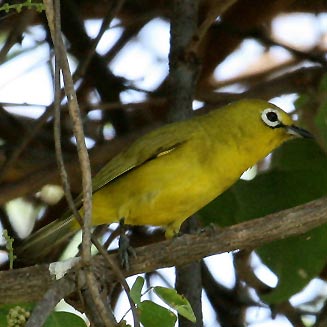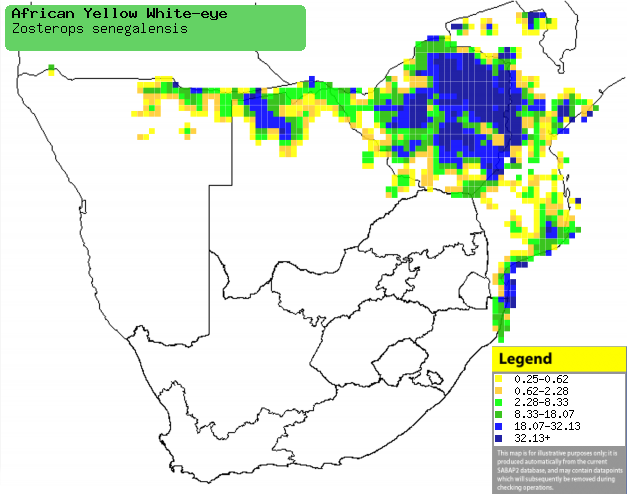|
Zosterops senegalensis (African
yellow white-eye)
Geelglasogie [Afrikaans]; umBicini, uMehlwane [Zulu];
Kahwarameso [Shona]; Manqiti (generic term for white-eye) [Tsonga]; Afrikaanse
brilvogel [Dutch]; Zostérops jaune [French]; Senegalbrillenvogel [German];
Olho-branco-amarelo [Portuguese]
Life
> Eukaryotes >
Opisthokonta
> Metazoa (animals) >
Bilateria >
Deuterostomia > Chordata >
Craniata > Vertebrata (vertebrates) > Gnathostomata (jawed
vertebrates) > Teleostomi (teleost fish) > Osteichthyes (bony fish) > Class:
Sarcopterygii (lobe-finned
fish) > Stegocephalia (terrestrial
vertebrates) > Tetrapoda
(four-legged vertebrates) > Reptiliomorpha > Amniota >
Reptilia (reptiles) >
Romeriida > Diapsida > Archosauromorpha > Archosauria >
Dinosauria
(dinosaurs) > Saurischia > Theropoda (bipedal predatory dinosaurs) >
Coelurosauria > Maniraptora >Aves
(birds) > Order: Passeriformes
> Family: Zosteropidae
 |
|
|
African Yellow white-eye, Botswana. [photo
Mike Grimes ©] |
|
Distribution and habitat
Occurs across much of sub-Saharan Africa, absent only from
the Congo basin and very arid areas. In southern Africa its distribution is
centered in Zimbabwe, extending west to northern Botswana and Namibia and east
to Mozambique. It generally prefers well-wooded habitats, especially miombo (Brachystegia),
Zambezi teak (Baikiaea plurijuga) and mohobohobo (Uapaca)
woodland, also occupying swamps with interspersed trees, thorny scrub,
Eucalyptus plantations, suburban parks and gardens.
|
 |
|
Distribution of African yellow white-eye in
southern Africa, based on statistical smoothing of the records from
first SA Bird Atlas Project (©
Animal Demography unit, University of
Cape Town; smoothing by Birgit Erni and Francesca Little). Colours range
from dark blue (most common) through to yellow (least common).
See here for the latest distribution
from the SABAP2. |
Brood parasites
It has been recorded as host of the
Green-backed honeybird.
Food
It mainly eats insects, doing most of its foraging in the
tree canopy, gleaning prey from leaves and branches. It regularly joins
mixed-species foraging flocks,. The following food items have been recorded
in its diet:
- Insects
- Fruit
- Ficus (figs)
- Cussonia (cabbage-trees)
Breeding
- The nest is a small cup built of dried grass and small twigs, secured with
spider web. It is typically placed in the foliage of a sapling, often about
3-5 metres above ground in the shade.
- Egg-laying season is from August-January, peaking from
September-October.
- It lays 2-4 eggs, which are incubated by both sexes for about 11-12
days.
- The chicks are cared for by both parents, leaving the nest after about
13-14 days. If the nest is disturbed the chicks will often jump out in a
panic.
Threats
Not threatened.
References
-
Hockey PAR, Dean WRJ and Ryan PG 2005. Roberts
- Birds of southern Africa, VIIth ed. The Trustees of the John Voelcker
Bird Book Fund, Cape Town.
|
